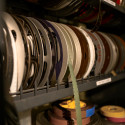Research seeks to improve fuel cells
As the United States and other countries move toward fuel cells as a source of power, researchers at UW–Madison are moving toward a better understanding of how to improve the function of these power sources.
Fuel cells get their energy from hydrogen. But generally when hydrogen is produced, it contains large amounts of carbon monoxide. If this gas isn’t removed, the function of a fuel cell could be impaired.
Research has shown that gold packaged into tiny nanoparticles and placed on a support surface can remove carbon monoxide by turning it into carbon dioxide. Why exactly this technique works has been debated, but now a team led by James Dumesic, professor of chemical and biological engineering, has demonstrated that the secret lies in water.
Basically, the researchers created a surface with protruding gold nanotubes. They placed the surface between two chambers — one containing carbon monoxide and oxygen molecules, and one containing water. They not only found that the gold nanotubes catalyzed the reaction to form carbon dioxide, but they did so at a faster rate when water was present inside the tubes or on the surface. This finding, the researchers note, fits with what scientists have observed with gold nanoparticles on certain support surfaces.
With more attention being turned to hydrogen energy, this new knowledge may make more efficient catalysts for hydrogen production and, as a result, better fuel cells.
Tags: research




